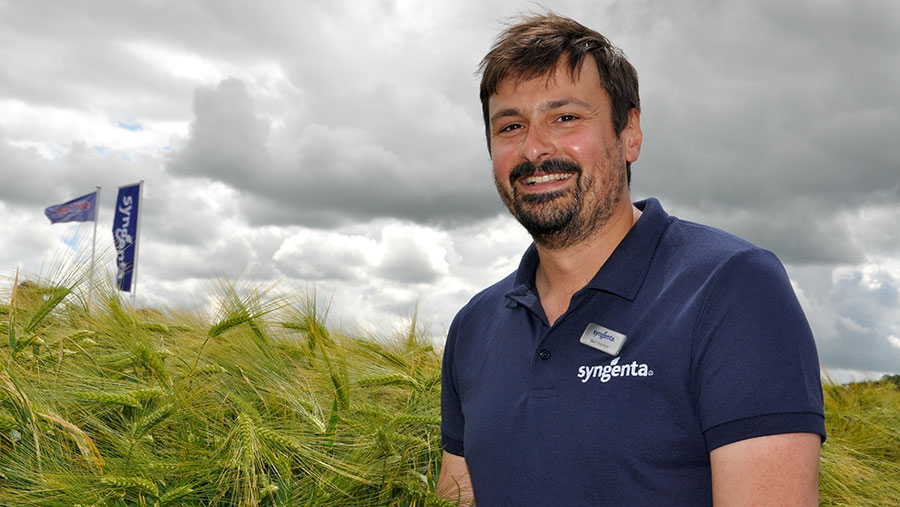Advertiser content
Prioritise crops of hybrid barley for nitrogen applications
Provided by
Syngenta is one of the world’s leading agricultural companies, comprising of crop protection and seeds. Our ambition is to safely help feed the world while taking care of the planet.
The prolonged wet weather across much of the UK has left many fields waterlogged.
Crop rooting is likely to be less extensive and with the worst of the wet conditions resulting in root cell death and crops struggling.
Therefore, it is important to prioritise crops of hybrid barley for their first application of nitrogen fertiliser.
Hybrid barley technical expert, Ben Urquhart, explains why this early application can make so much difference.

Ben Urquhart © Syngenta
“The amount of rainfall over much of the country this winter has meant that much of the autumn cropping has had a pretty tough time.
Syngenta research has shown that an early first dose of nitrogen supports the vigorous spring growth of the hybrids and following the extremely wet conditions, this will help crops of hybrid barley bolster their root density and tillering capacity.”
Nitrogen will help drive grass weed suppression
Early first dose of nitrogen (N) will also help to drive grass weed suppression and give a boost to crops where barley yellow dwarf virus (BYDV) symptoms are visible.
Growers should aim to apply the first split of nitrogen in the spring at around mid-tillering (GS25). It is important to apply nitrogen to those crops which are ready to take it up.
Root zone temperatures which have reached 4.5-5oC give a good indication that applied nitrogen will be taken up immediately by the crop rather than sitting unused in the soil.
Ensure ground conditions are suitable
It is also extremely important to make sure that ground conditions are suitable for application.
Ben explains: “It might sound obvious – but applying bagged fertiliser onto wet fields or before rain is forecast could lead to nitrogen ending up elsewhere.”
It is important to follow local best practice guidelines and make sure conditions are suitable for fertiliser applications, avoiding applications on soils that are snow-covered, frozen or waterlogged.
Trials show a three-split programme delivers optimum performance
Syngenta trials indicate that applying the total planned dose of nitrogen in a three-split programme, with 30% at GS25, 50% at or just before GS31 and 20% two to three weeks after the second application, delivers optimum performance from the hybrid varieties.
Splitting the dose three ways may also help to mitigate risk and the impact of unfavourable weather conditions.
Each application targets a crucial stage in hybrid barley development:
- The early dose encourages tiller production, retention and supports rapid growth
- The second application supports tiller survival and canopy expansion through rapid leaf emergence
- The final application supports canopy size increase.
“It is important to remember that the rapid early growth of hybrid barley is above and below ground, so early N really is helping to set the foundation of a successful crop.”
If conditions mean that the crop is beyond GS25 before the first application has been made, it may be worth considering a two-split programme of 50% followed by 50% three to four weeks later.
This may also be appropriate especially if farm workloads are high, as well as a management option for boosting thin crops or those recovering from waterlogged soils.
With a two- or three-split programme the first timing remains critical to hybrid performance Mr Urquhart explains: “Whilst the weather at this time of year doesn’t always do what we want, the one timing not to miss is the first one as we have seen time and time again that early N is crucial to get the most out of your hybrid barley variety.”
Nitrogen dose rate should be tailored to every situation and calculated on a field-by-field basis in conjunction with a Facts-qualified adviser.
Nitrogen use efficiency benefit
Hybrid barley demonstrates significantly improved nitrogen use efficiency when compared to conventional varieties.
Syngenta trials in conjunction with Adas have indicated that hybrid barley may have significantly better nitrogen use efficiency (NUE) than conventional barley.
Following on from six years of German trials work, a three-year project in the UK has demonstrated a NUE benefit.
Results indicate that hybrid barley has superior nitrogen use efficiency, driven by an improvement in utilisation of nitrogen – this suggests that the hybrid crop is able to “do more with less”.
“These results should provide a level of confidence to growers who are looking to make modest reductions in their N rates with hybrid barley, in response to cost and sustainability pressures” says Dr Sarah Kendall of Adas.
Any reduction in total nitrogen dose is likely to have an impact on final yield.
Syngenta trials in conjunction with Adas indicate that hybrid barley demonstrates significantly improved NUE when compared to conventional varieties, so the impact of a reduction in nitrogen is likely to have a less pronounced effect on hybrid varieties compared to conventional varieties.
If considering a reduction in total dose, a two-split (50:50:0) may be more appropriate, but it remains important to prioritise crops of hybrid barley for the first timing of nitrogen at GS25 in the spring.
